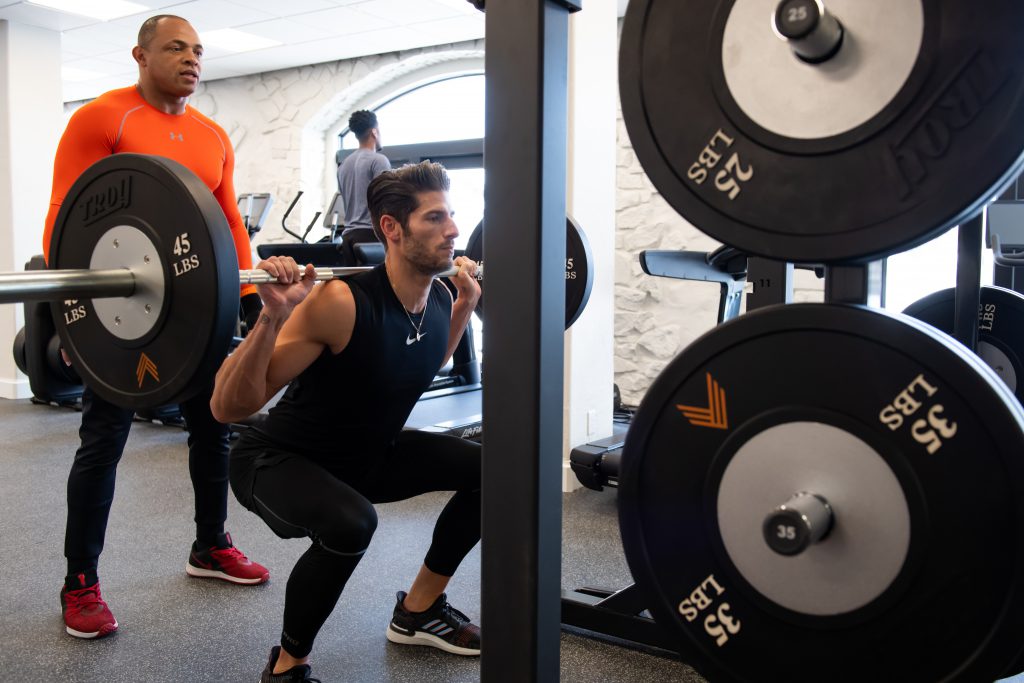Physical activity in recovery is one of many adjunct treatments that can help improve substance abuse treatment outcomes. Exercise can improve your emotional and physical well-being. Physical activity can help you create a healthy daily routine and build recovery capital beyond treatment.
Aside from achieving long-term abstinence, recovering from substance misuse is about building a better quality of life. Many healthy lifestyle interventions such as movement, meditation, or creative expression can become hobbies that offer stability, joy, and fulfillment. Exercise helps support recovery behaviors because it immediately boosts your mood and stimulates the brain’s reward system with consistent effort.
Exercise as an Adjunct Treatment for Substance Use Disorders
Physical activity can provide tangible benefits for individuals with substance use disorders. Academic studies have shown that exercise can¹:
- Reduce relapse rates
- Decrease drug-seeking behavior
- Provide a reinforcing behavior outside of substance use
These benefits make physical activity a valuable component of any quality treatment program.
Another critical component of the recovery process is learning to maintain a sober lifestyle. Most people entering recovery have spent a large portion of their daily lives planning, preparing, and engaging in addictive behaviors. After achieving abstinence, they can find themselves with an excess amount of idle time and no clear plan of how to use it.
Engaging in exercise is an excellent way to find purpose and passion in early and long-term recovery. Physical activities provide a healthy way to spend free time without substance use.
Cognitive Benefits of Physical Activity in Recovery
Substance misuse affects the brain in ways that make it difficult to find everyday activities rewarding. Recreational drugs affect the brain’s reward pathways, releasing dopamine at levels above and beyond the natural levels produced from other activities.
After sustained use, the brain adapts to this increased dopamine release. This is the hallmark neurological characteristic of substance use disorders and is why people often lack interest in other activities after long-term substance abuse.
Highly rewarding dopaminergic activities such as competitive sports or intense exercise are some of the best ways to encourage neuroplasticity and create routines around healthy activity after substance use. Exercise can mimic the effect of certain drugs, engaging the same reward pathways that recreational drugs exploit.
Physical activity releases endogenous opioids, increases dopamine production, and is a self-reinforcing behavior². This accounts for the phenomenon known as “runner’s high.” Therefore, movement and exercise may help those in recovery battle cravings and better cope with unwanted side effects of substance use withdrawal.
Exercise for Whole Health
The best recovery programs take a whole-person approach for healing in mind, body, and spirit. Regular physical activity is an essential component in most models for treating addiction. Beyond improving substance misuse outcomes, physical activity in recovery is also a key component of holistic wellness.
Exercise can help with a variety of different conditions that often co-occur with substance use disorders, such as:
- Depression
- Anxiety
- Poor sleep quality
- Physical ailments like cardiac disease and diabetes
Exercise helps each area of a person’s health differently, so let’s explore them in more detail.
Depression
Depression is one of the leading causes of mental health problems in adults. It’s also one of the effects of Post-Acute Withdrawal Syndrome (PAWS), which affects many people detoxing from substance use disorders.
Regular physical activity such as weight lifting, cardiovascular exercise, or high-intensity interval training can improve the symptoms of depression and help to prevent its onset³. One study showed that 75% of people who engaged in regular exercise saw either total remission or significant improvement in their depressive symptoms³.
Compared to other treatments for depression, regular physical activity has effects comparable to leading antidepressant medications and cognitive behavioral therapy³.
Anxiety
Many people new to recovery face significant anxiety when transitioning to a new way of living. Similar to its impact on depression, exercise is beneficial for those who suffer from anxiety.
Physical activity provides a distraction from intrusive thoughts and can help deal with the most immediate sources of anxiety. Exercise also helps relieve muscle tension which contributes to the bodily sensations associated with anxious thinking or feeling. Moving your body causes the brain to release endogenous chemicals that naturally relieve anxiety, such as serotonin and endocannabinoids.
Sleep
Quality sleep is often an overlooked component of emotional and physical health. Consistent adequate sleep is associated with numerous benefits such as stronger immunity, reduced stress, and improved cognitive functioning.
Regular exercise can help people fall asleep easier, have higher quality sleep, maintain a healthy sleep schedule, and avoid insomnia, which is common for people in recovery. Moderate-intensity exercise can also decrease daytime drowsiness and reduce dependence on sleep medications. Individuals who exercise less are more likely to report sleep difficulties like insomnia, sleep apnea, or sleeping less than six hours a night.
Physical Health
While regular physical activity is beneficial for most people, it can be particularly important for individuals in recovery. Stimulant drugs like cocaine or methamphetamines can lead to cardiovascular disease and complications⁵ ⁶. Alcohol use can lead to chronic inflammation of the pancreas, resulting in symptoms associated with diabetes⁷.
Substance abuse can wreak havoc on the body, but the secondary issues associated with substance use disorders can also cause damage – many people in active addiction struggle with eating a balanced diet and staying active. Abstaining from substance use and incorporating regular exercise can help repair the damage from substance abuse complications to improve quality of life and overall well-being.
Regular cardiovascular exercise can reduce the rate of heart disease by 21% in men and 29% in women⁴. It can also reverse the course of diabetes if caught early enough.
Stress
Lastly, exercise can be an excellent source of stress relief. Most people seeking treatment for substance misuse feel overwhelmed by associated personal issues they need to address. While exercise doesn’t solve those problems, it can make them feel more manageable.
People who exercise regularly are better equipped to deal with stressful situations. This can make all the difference in maintaining recovery when life becomes overwhelming.
Building Recovery Capital
Building recovery capital can have a significant impact on long-term recovery. Recovery capital is a term used to describe the accumulation of positive elements in your life that depend on your recovery, such as improved social relationships, a renewed sense of purpose, and a sense of belonging in a recovery community. Recovery capital helps prevent relapse by developing a structure of positive life outcomes, and when you work hard to achieve these outcomes, you’re less likely to return to substance use.
Physical activity in recovery can be a significant contributor to recovery capital. The renewed sense of health and the social component of group exercise stand in direct opposition to addiction. The drive to maintain the value of the recovery capital you’ve built can be a strong deterrent against relapse.
Going Beyond Physical Activity
Physical activity alone isn’t enough to end a history of substance misuse, but it plays a vital role in the whole-person care model of addiction treatment. Regular exercise can increase overall well-being and physical health, reduce symptoms of depression and anxiety, improve sleep quality, and become a valuable source of social connection.
For most people, recovery takes more than just physical activity. At All Points North Lodge, we incorporate physical activity, evidence-based practices, therapeutic technologies, and custom programming to achieve sustained recovery in an optimal healing environment. We can work with you to create a custom plan and help you find your way forward in treatment and well into recovery. Contact one of our recovery experts at (855) 510 4585 or start a now.
Reference
- Smith, Mark A, and Wendy J Lynch. “Exercise as a potential treatment for drug abuse: evidence from preclinical studies.” Frontiers in Psychiatry vol. 2 82. 12 Jan. 2012, doi:10.3389/fpsyt.2011.00082
- Saanijoki, Tiina et al. “Opioid Release after High-Intensity Interval Training in Healthy Human Subjects.” Neuropsychopharmacology : official publication of the American College of Neuropsychopharmacology vol. 43,2 (2018): 246-254. doi:10.1038/npp.2017.148
- Gourgouvelis, Joanne, et al. “Exercise Leads to Better Clinical Outcomes in Those Receiving Medication Plus Cognitive Behavioral Therapy for Major Depressive Disorder.” Frontiers in Psychiatry, 6 Mar. 2018, https://www.frontiersin.org/articles/10.3389/fpsyt.2018.00037/full.
- Darden, Douglas et al. “Physical Activity and Exercise for Secondary Prevention among Patients with Cardiovascular Disease.” Current cardiovascular risk reports vol. 7,6 (2013): 10.1007/s12170-013-0354-5. doi:10.1007/s12170-013-0354-5
- Dickson, Stephen D., et al. “Methamphetamine‐Associated Heart Failure Hospitalizations Across the United States: Geographic and Social Disparities.” Journal of the American Heart Association, 7 Aug. 2021, https://www.ahajournals.org/doi/10.1161/JAHA.120.018370.
- Kim, Sung Tae, and Taehwan Park. “Acute and Chronic Effects of Cocaine on Cardiovascular Health.” International journal of molecular sciences vol. 20,3 584. 29 Jan. 2019, doi:10.3390/ijms20030584
- Apte, M V et al. “Alcohol-related pancreatic damage: mechanisms and treatment.” Alcohol health and research world vol. 21,1 (1997): 13-20.
- Linke, Sarah E, and Michael Ussher. “Exercise-based treatments for substance use disorders: evidence, theory, and practicality.” The American journal of drug and alcohol abuse vol. 41,1 (2015): 7-15. doi:10.3109/00952990.2014.976708







